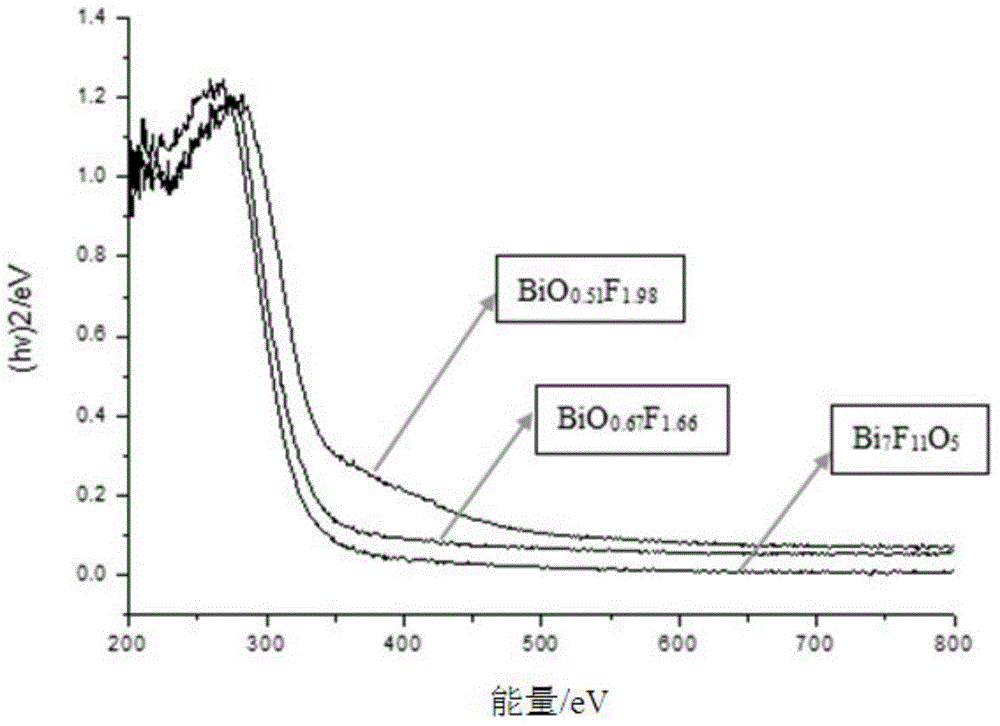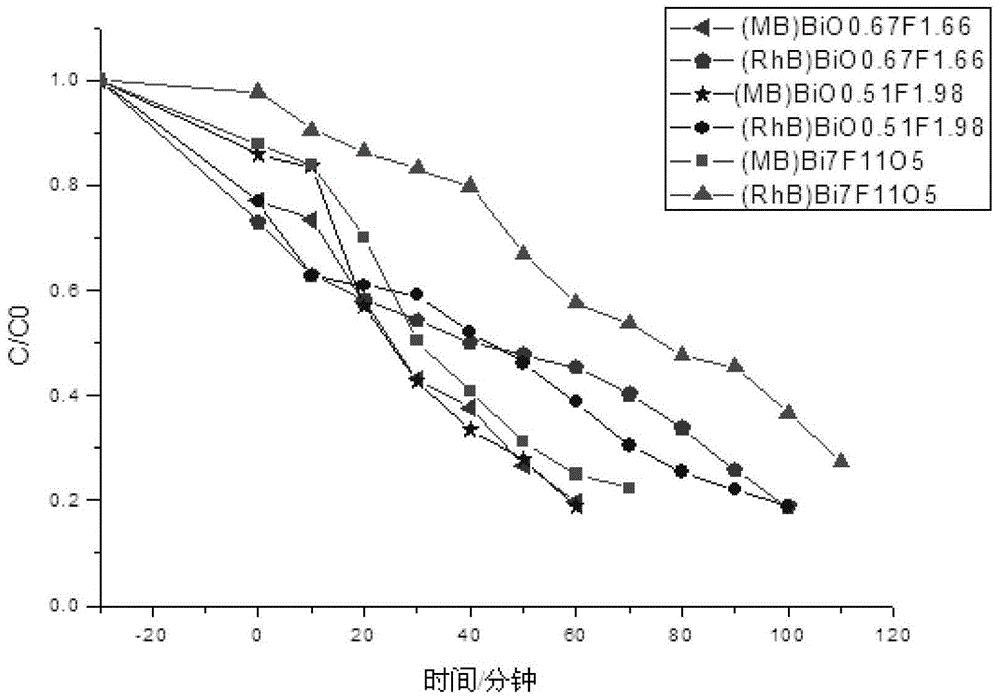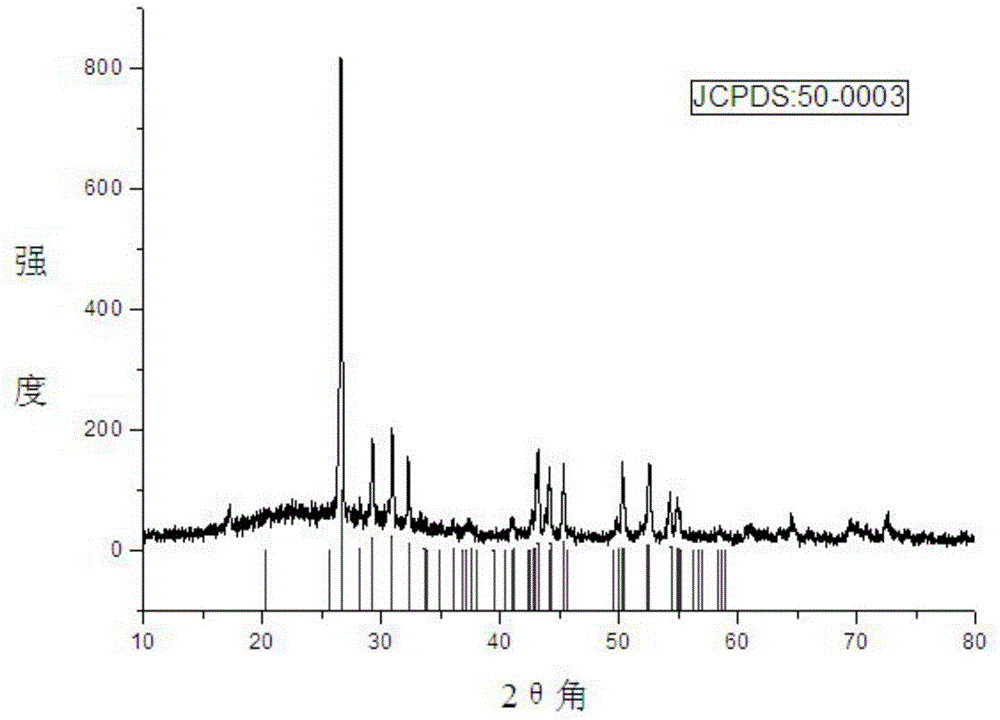Bismuth oxyfluoride photocatalyst and preparing method of bismuth oxyfluoride photocatalyst
A photocatalyst, bismuth oxyfluoride technology, applied in physical/chemical process catalysts, chemical instruments and methods, chemical/physical processes, etc. The effect of good shape, high catalytic activity and simple method
- Summary
- Abstract
- Description
- Claims
- Application Information
AI Technical Summary
Problems solved by technology
Method used
Image
Examples
Embodiment 1
[0030] Example 1: Bi 7 O 5 F 11 Preparation of Bismuth Oxyfluoride Photocatalyst
[0031] (1) Preparation of glacial acetic acid solution: add 30ml of glacial acetic acid to 30ml of water, that is, mix glacial acetic acid and water at a volume ratio of 1:1, and stir;
[0032] (2) Dissolving in a water bath: take 30ml of glacial acetic acid solution, add 0.4851g (1mmol) of bismuth nitrate pentahydrate and 0.0840g (2mmol) of sodium fluoride, stir in a constant temperature water bath at 80°C for 30 minutes, and dissolve the bismuth nitrate and sodium fluoride to obtain mixture;
[0033] (3) Hydrothermal reaction: Add the above mixed solution into the polytetrafluoroethylene lining, conduct a hydrothermal reaction at a constant temperature of 150°C for 10.5 hours, centrifuge at 3000 rpm for 3 minutes, wash with distilled water and absolute ethanol in turn, and dry at 60°C for 4 hours , that is Bi 7 o 5 f 11 Bismuth oxyfluoride photocatalyst.
[0034] Depend on ...
Embodiment 2
[0035] Example 2: BiO 0.51 F 1.98 Preparation of Bismuth Oxyfluoride Photocatalyst
[0036] (1) Preparation of glacial acetic acid solution: add 30ml of glacial acetic acid to 30ml of water, that is, mix glacial acetic acid and water at a volume ratio of 1:1, and stir;
[0037] (2) Dissolving in a water bath: take 30ml of glacial acetic acid solution, add 0.4851g (1mmol) of bismuth nitrate pentahydrate and 0.0840g (2mmol) of sodium fluoride, stir in a constant temperature water bath at 80°C for 30 minutes, and dissolve the bismuth nitrate and sodium fluoride to obtain mixture;
[0038] (3) Hydrothermal reaction: Add the above mixed solution into the polytetrafluoroethylene lining, conduct a hydrothermal reaction at a constant temperature of 150°C for 11.5 hours, centrifuge at 3000 rpm for 3 minutes, wash with distilled water and absolute ethanol in turn, and dry at 60°C for 4 hours , namely BiO 0.51 f 1.98 Bismuth oxyfluoride photocatalyst.
[0039] Depend on ...
Embodiment 3
[0040] Example 3: BiO 0.67 F 1.66 Preparation of Bismuth Oxyfluoride Photocatalyst
[0041] (1) Preparation of glacial acetic acid solution: add 30ml of glacial acetic acid to 30ml of water, that is, mix glacial acetic acid and water at a volume ratio of 1:1, and stir;
[0042] (2) Dissolving in a water bath: take 30ml of glacial acetic acid solution, add 0.4851g (1mmol) of bismuth nitrate pentahydrate and 0.0840g (2mmol) of sodium fluoride, stir in a constant temperature water bath at 80°C for 30 minutes, and dissolve the bismuth nitrate and sodium fluoride to obtain mixture;
[0043] (3) Hydrothermal reaction: Add the above mixed solution into the polytetrafluoroethylene lining, conduct a hydrothermal reaction at a constant temperature of 150°C for 12.5 hours, centrifuge at 3000 rpm for 3 minutes, wash with distilled water and absolute ethanol in turn, and dry at 60°C for 4 hours , namely BiO 0.67 f 1.66 Bismuth oxyfluoride photocatalyst.
[0044] Depend on ...
PUM
 Login to View More
Login to View More Abstract
Description
Claims
Application Information
 Login to View More
Login to View More - R&D
- Intellectual Property
- Life Sciences
- Materials
- Tech Scout
- Unparalleled Data Quality
- Higher Quality Content
- 60% Fewer Hallucinations
Browse by: Latest US Patents, China's latest patents, Technical Efficacy Thesaurus, Application Domain, Technology Topic, Popular Technical Reports.
© 2025 PatSnap. All rights reserved.Legal|Privacy policy|Modern Slavery Act Transparency Statement|Sitemap|About US| Contact US: help@patsnap.com



